Multiple Substance Use Among Adolescents in Scotland: Profile and Trends
This report examines the prevalence of regular use of 2 or more substances among adolescents in Scotland, and key factors associated with multiple substance use.
This document is part of a collection
3 Profile of multiple substance users in 2013
Key Findings
- Nineteen per cent of 15 year olds had used any substance. Less than half of those were using more than one (8%).
- Overall, 15 year old boys were more likely to have used any substance than 15 year old girls (20% of boys, compared with 18% of girls).
- Many factors showed a relationship with multiple substance use across the different themes explored. However, two main themes emerged: engagement with school and supervision/structure of free time:
• Pupils who were disengaged from school were more likely to be multiple substance users - higher rates of exclusion and truanting were associated with using two or more substances.
• Pupils who spent more leisure time unsupervised and in unstructured activities were more likely to be multiple substance users - more time spent out with friends and hanging in the streets, and lower club/group membership and parental knowledge of pupils' activities were associated with using two or more substances. - Other factors that were associated with higher levels of multiple substance use included:
• Friendships with older pupils
• Having no close friends
• Poor mental health - particularly in relation to conduct problems
• Free School Meal entitlement
• Reporting a mixed or multiple ethnic identities. - Pupils who thought that they would go to university once they left school were less likely to use multiple substances
3.1 Figure 3.1 provides a detailed breakdown of multiple substance use among 15 year olds. Overall, 19% of pupils used at least one substance regularly. More than half of those (11%) had only used one substance: 6% were weekly drinkers only, 3% had used drugs in the last month only and 2% were regular smokers only.
3.2 Of the 8% of pupils who had used more than one substance, 3% used all three substances regularly, 2% had smoked and used drugs regularly, 2% drank and used drugs regularly and 1% smoked and drank regularly (Figure 3.1).
Figure 3.1: Detailed substance use breakdown among 15 year olds in 2013[5]
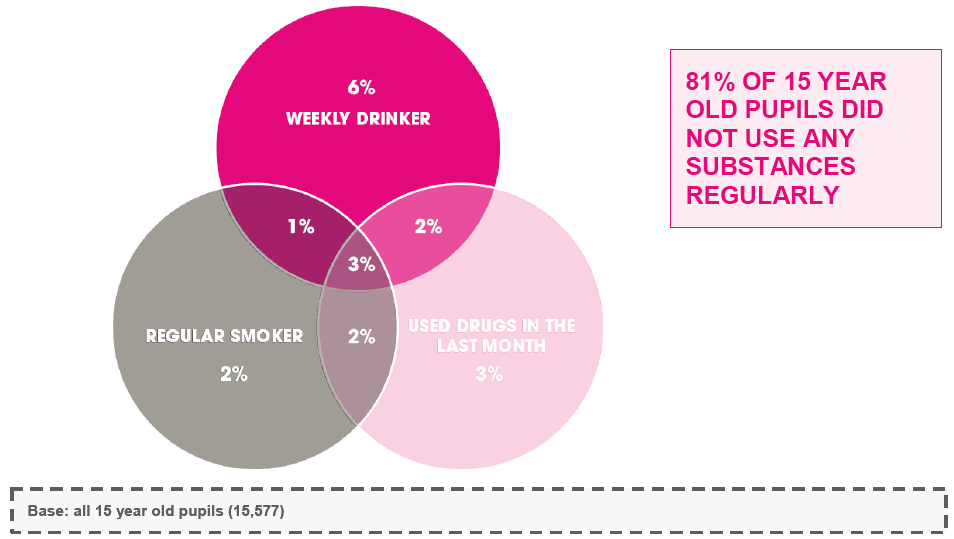
3.3 Overall, boys were slightly more likely than girls to use any substances (20% of boys, compared with 18% of girls). Boys were also more likely to have only used drugs in the last month, or to have drunk weekly and used drugs in the last month. However, girls were more likely than boys to be regular smokers only. It should be borne in mind that while these are statistically significant differences, they are very small and that the profile for males and females is very similar (Figure 3.2).
Figure 3.2: Detailed substance use among 15 year olds by sex in 2013
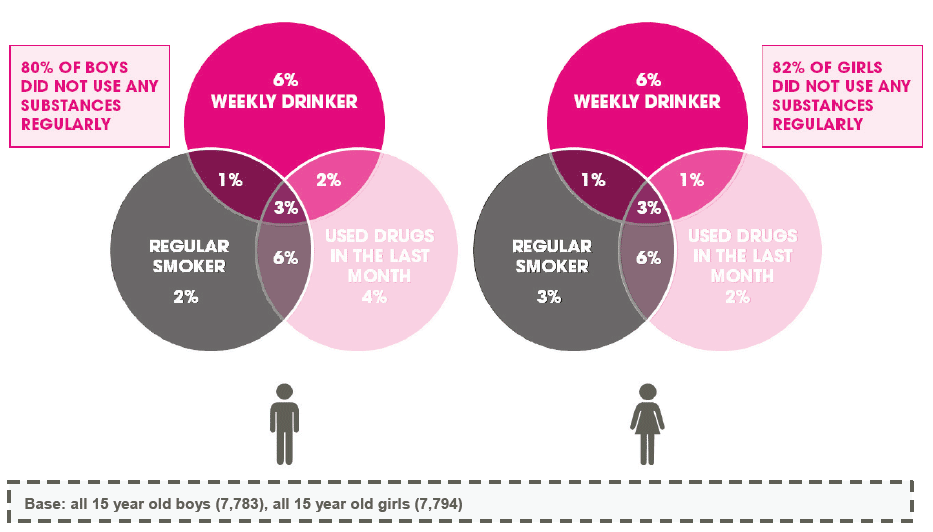
3.4 Those who drank on a regular basis were the least likely to have used another substance as well: 50% of weekly drinkers used at least one other substance on a regular or recent basis, compared with 70% of those who used drugs in the last month and 75% of regular smokers.
3.5 The following sections explore the profile of multiple substance users in more detail under several thematic headings (geography, family, friends, mental health, school and leisure activities). Comparisons are made between those using two or more substances, one substance, and no substances regularly or recently.
Geography and deprivation
Existing findings from other sources
- Free school meals entitlement was associated with increased prevalence of substance use (2).
- Prevalence of substance use is higher among those who live in rural areas (3).
- Higher levels of deprivation are associated with higher levels of multiple substance use (4).
Figure 3.3: Number of substances used by Scottish Index of Multiple Deprivation[6] (SIMD) among 15 year olds in 2013
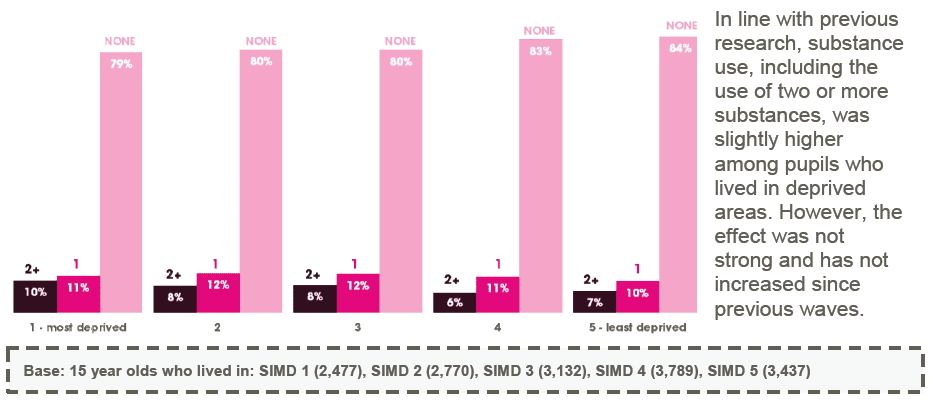
3.6 It should be borne in mind that using SIMD means that we are looking at an area based measure to identify deprivation in individuals. Many people who are materially disadvantaged as individuals live in areas that are not particularly deprived in terms of SIMD; equally, many people living in deprived areas (as identified by SIMD) may not be particularly disadvantaged. For that reason, it is also important to look at family level measures of deprivation (see Figures 3.5 and 3.11).
3.7 In 2013, 37% of pupils did not supply a postcode - either because they did not know it or did not want to write it in. Missing postcodes were imputed by sorting the data by class within schools. If a postcode was missing, the postcode of another randomly selected pupil from the same class was copied.
3.8 The figures suggest that those who did not provide a postcode were more likely to be those living in areas of deprivation (see Table 3.1). Imputing the postcodes improved this but those living in the most deprived areas were still underrepresented. The data was weighted to account for these differences.
Table 3.1 SALSUS 2013 - SIMD by postcode imputation[7]
| SIMD before postcode imputation and checking | SIMD after postcode imputation and checking | SIMD after weighting applied | Population estimates for 13 and 15 year olds 2013[8] | |
|---|---|---|---|---|
| SIMD 1 - most deprived | 16% | 17% | 18% | 20% |
| SIMD 2 | 17% | 18% | 19% | 18% |
| SIMD 3 | 20% | 20% | 19% | 19% |
| SIMD 4 | 24% | 24% | 24% | 21% |
| SIMD 5 - least deprived | 22% | 21% | 21% | 21% |
| Bases | 33,685 | 33,685 | 33,685 | 115,915 |
Figure 3.4: Number of substances used by urban/rural classification among 15 year olds in 2013
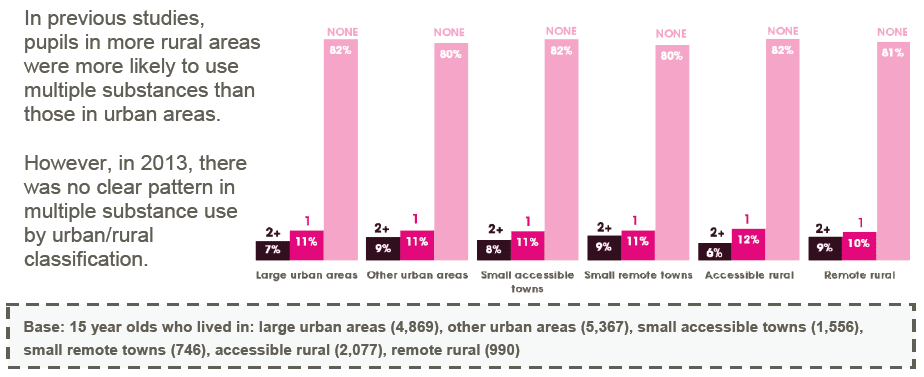
Figure 3.5: Number of substances used by free school meal entitlement[9] among 15 year olds 10 in 2013
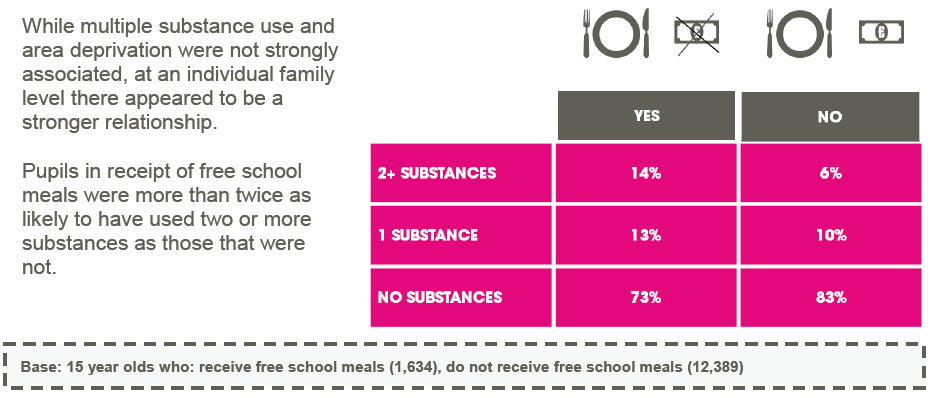
Figure 3.6: Number of substances used by local authority among 15 year olds[11] in 2013
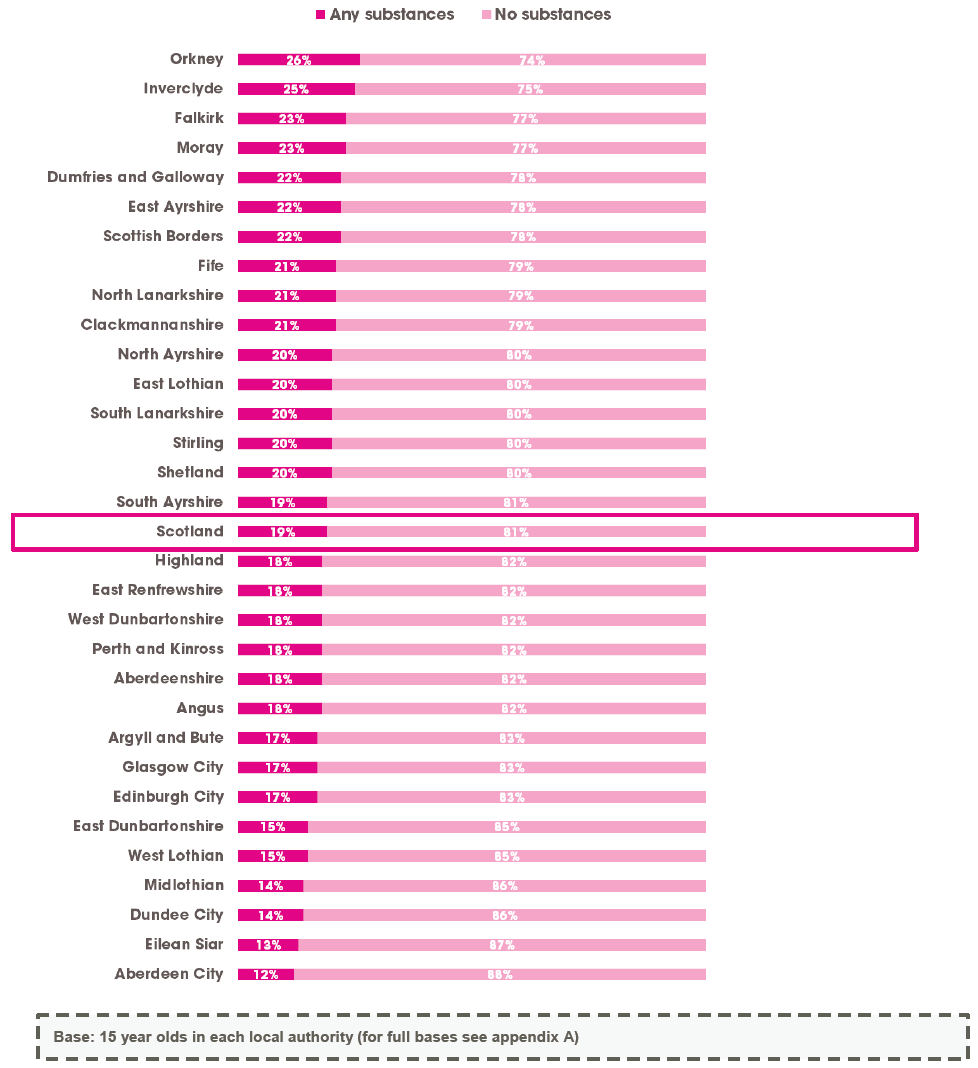
3.9 Across the 31 local authorities, the use of any substance regularly ranged between 12% and 26%. Regular substance use was most likely in Orkney[12], Inverclyde, Falkirk and Moray. Pupils in Eilean Siar, Midlothian, Dundee City and Aberdeen City were least likely to have used any substances (Figure 3.6).
Figure 3.7: Number of substances used by local authority among 15 year olds in 2013
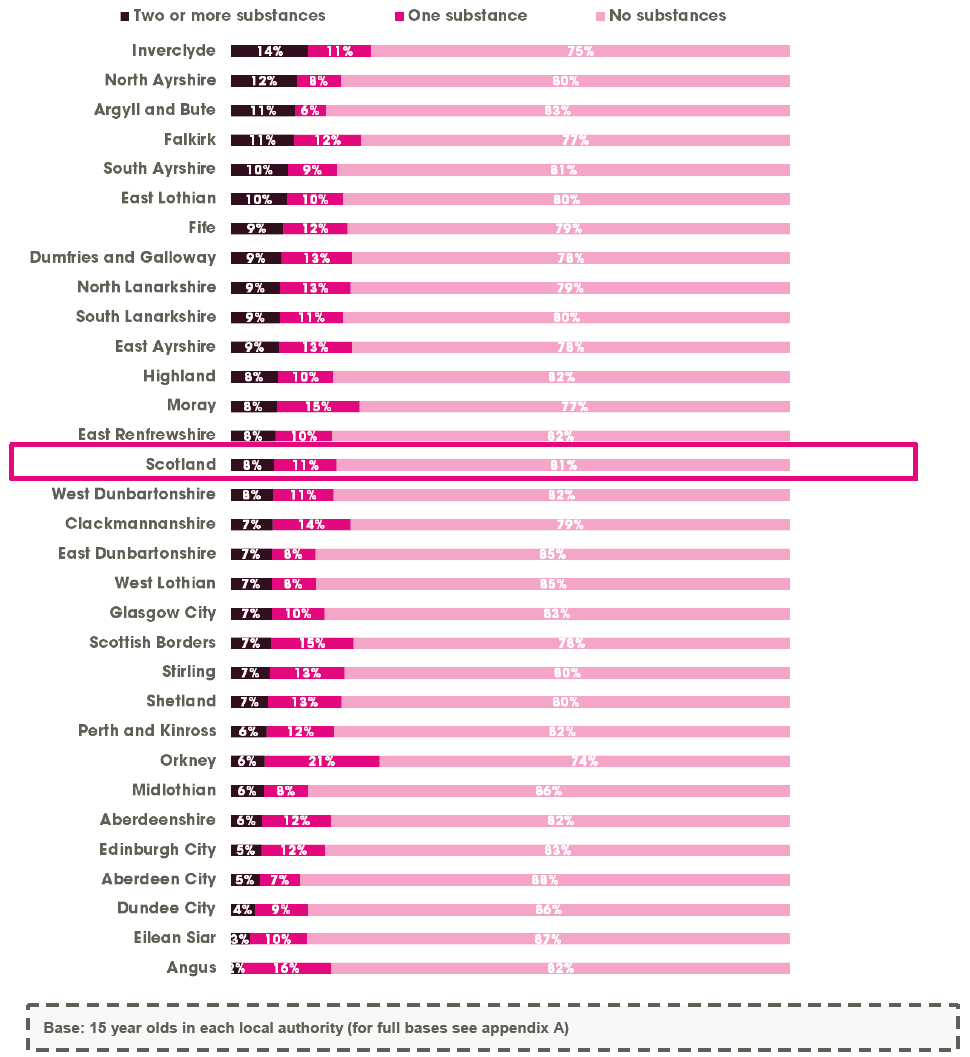
3.10 If we look at two or more substances used (Figure 3.7 and 3.8) Inverclyde and Falkirk are again among the areas were multiple substance use was most prevalent. Pupils in North Ayrshire, and Argyll and Bute were also more likely to than most other areas to use two or more substances. Angus, Eilean Siar, Dundee City and Aberdeen City were the areas with the lowest levels of multiple substance use.
Figure 3.8: Map of the use of two or more substances among 15 year olds in 2013
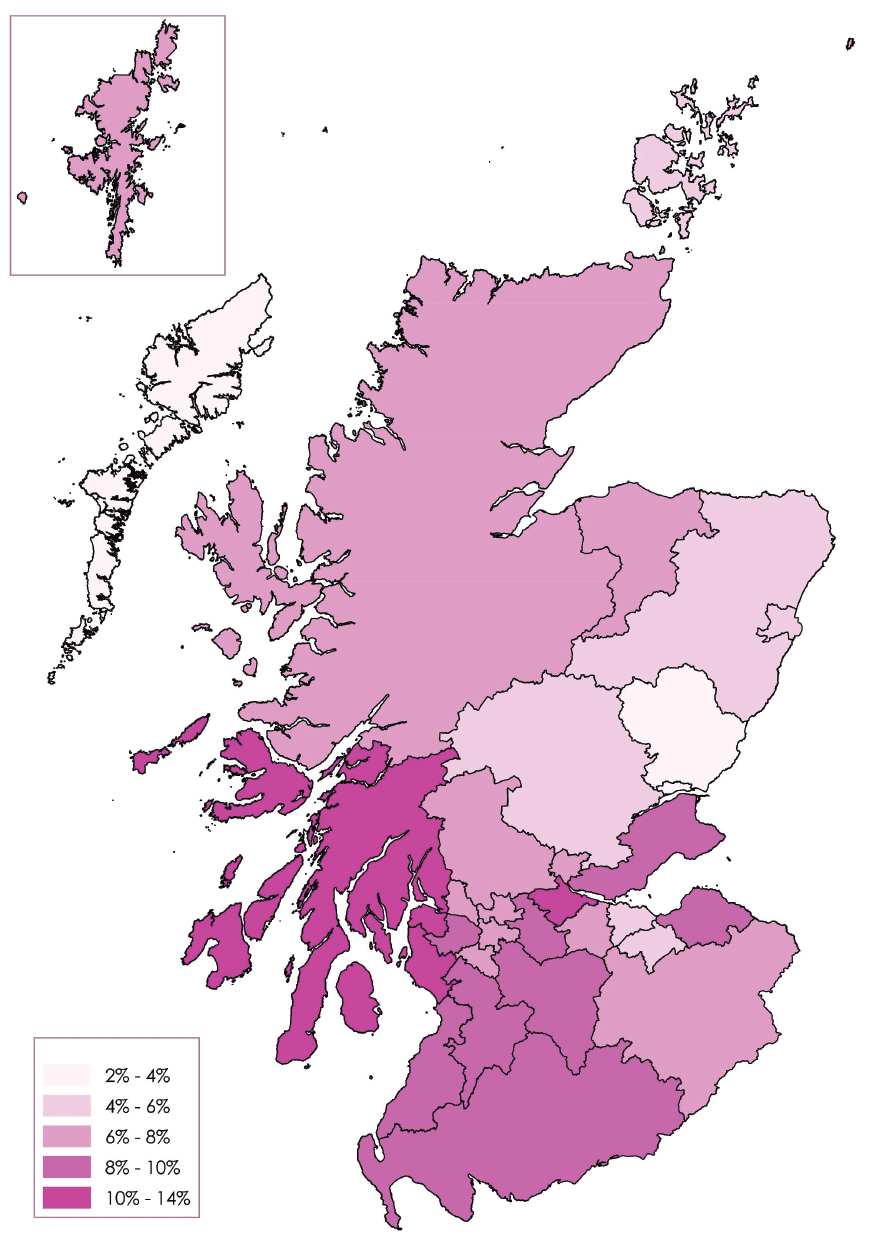
Family
Existing findings from other sources
- Family affluence and low family cohesion were associated with increased prevalence of substance misuse (5).
- Parental divorce, perceptions of parental disapproval, parental smoking habits and authoritative parenting styles create circumstances in which young people were more likely to use substances (6).
- Young people from single parent/step parent families were more likely to use substances (7) (8).
- Living with both parents was linked to lower levels of multiple substance use (4).
Figure 3.9: Number of substances used by family status among 15 year olds in 2013
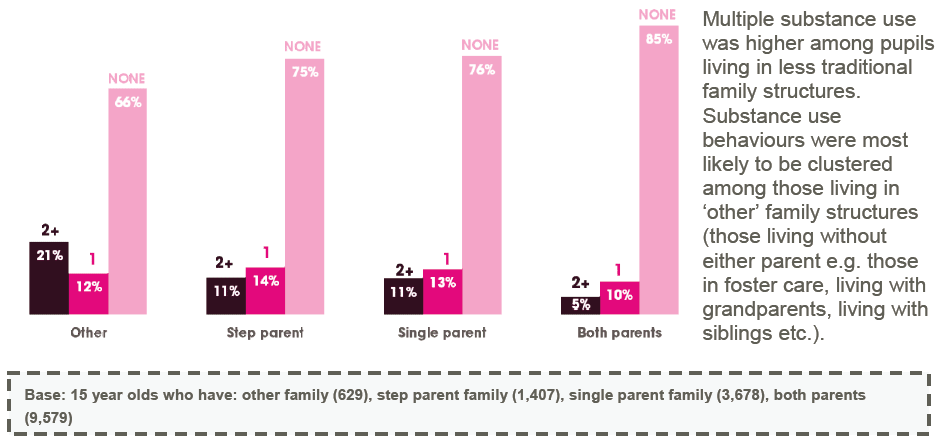
Figure 3.10: Number of substances used by maternal knowledge[13] among 15 year olds in 2013
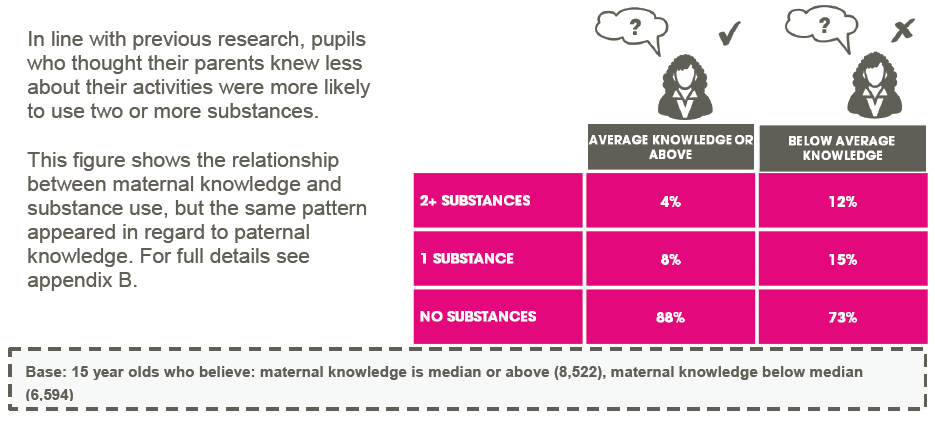
Figure 3.11: Number of substances used by perceived family affluence among 15 year olds in 2013
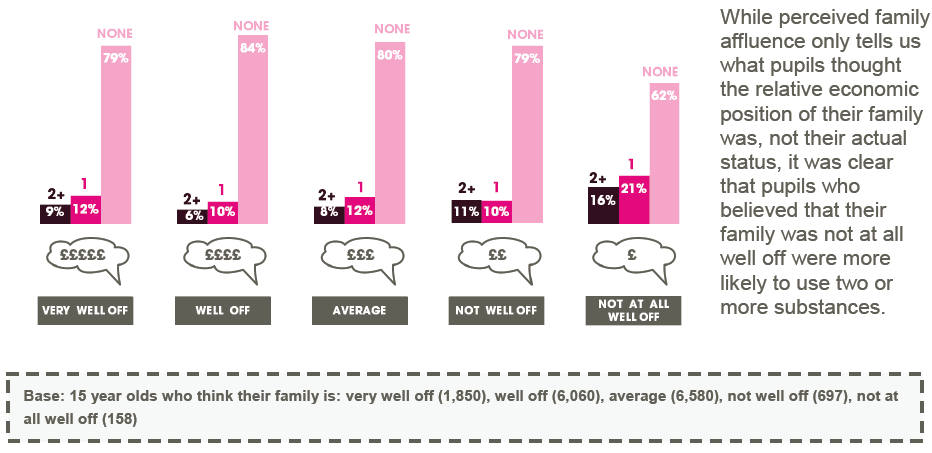
Friends
Existing findings from other sources
- There was an increased likelihood of smoking, drinking and drug use among young people under the influence of their peer groups (9).
- Increased cannabis consumption was associated with spending more time with friends (10).
- Young people tended to select friends who had common attributes and behaviours to them reinforcing substance use patterns and creating social opportunities for use (11).
- Variations existed within young people's susceptibility to peer influences based on social status, dependency and relationships with close friends (12).
- Pupils who spent many evenings out with friends were more likely to use multiple or single substances (3).
Figure 3.12: Number of substances used by age of friends among 15 year olds in 2013
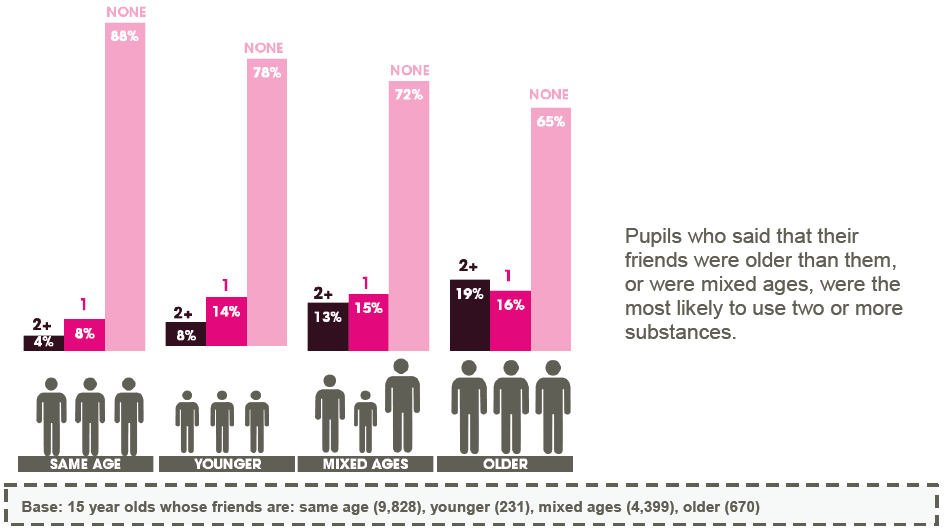
Figure 3.13: Number of substances used by number of close friends among 15 year olds in 2013
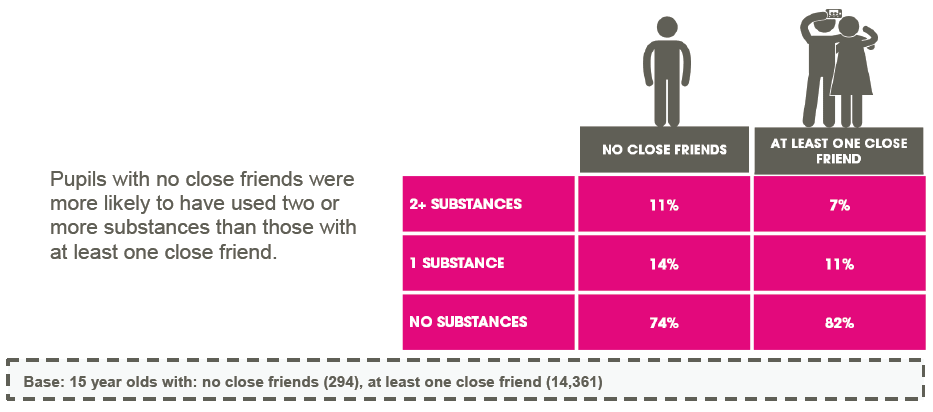
Figure 3.14: Number of substances used by number of evenings spent with friends among 15 year olds in 2013
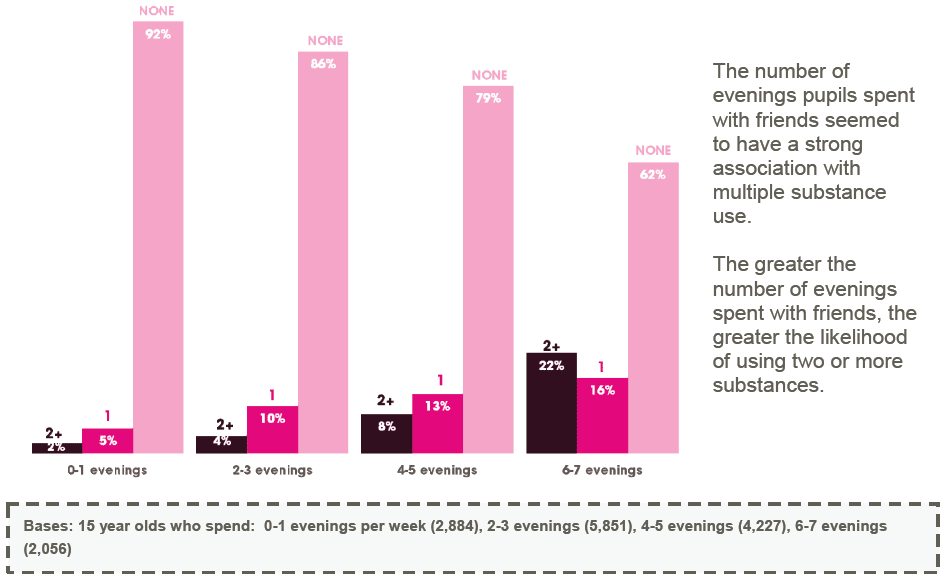
Mental health
Existing findings from other sources
- Young people in the UK used substances as a means to alleviate their moods (13).
- Low self-esteem and substance use were correlated among young people (14).
- Daily use of cannabis in female teenagers increased depression and anxiety (15).
Figure 3.15: Number of substances used by WEMWBS[14] banding among 15 year olds in 2013 (16)
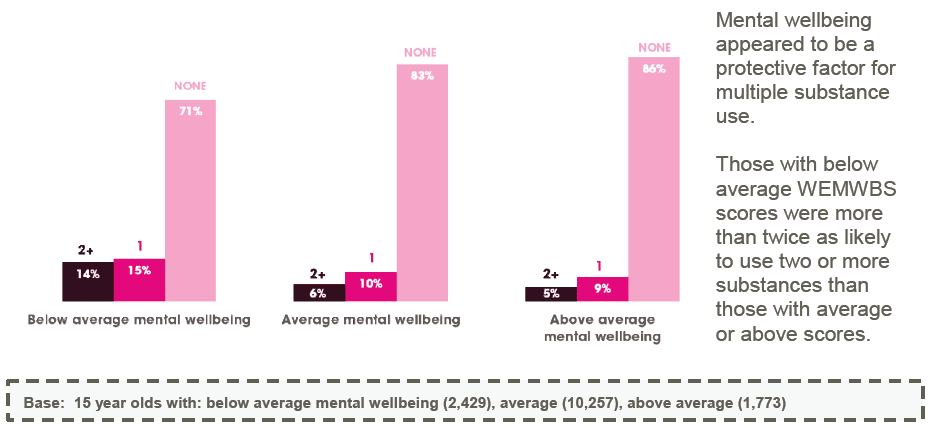
Figure 3.16: Number of substances used by Strengths and Difficulties score[15] among 15 year olds in 2013 (17)
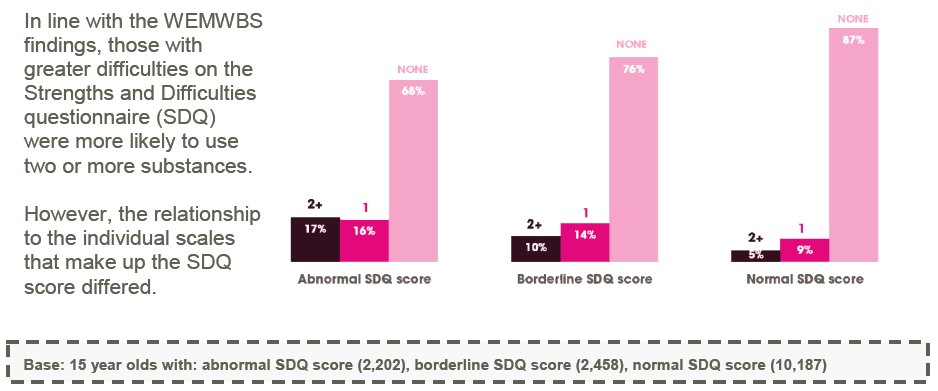
Figure 3.17: Use of two or more substances by individual SDQ scales[16] among 15 year olds in 2013
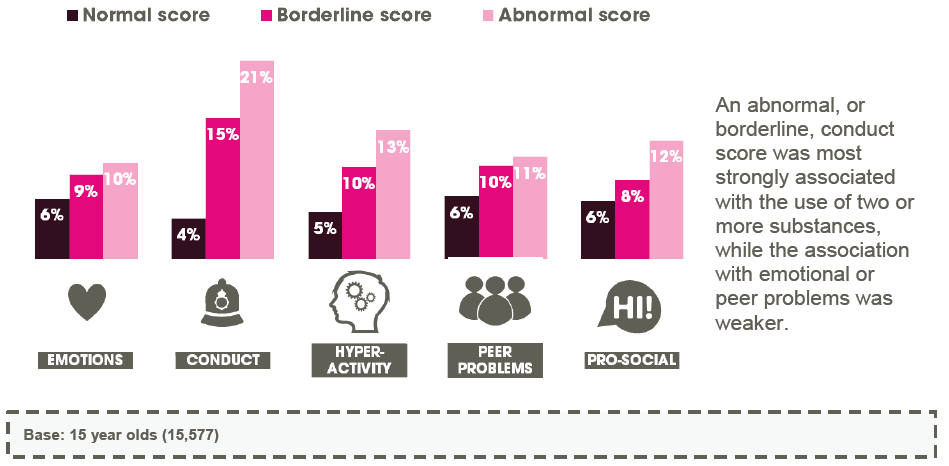
School
Existing findings from other sources
- Higher levels of truanting and exclusion were associated with higher levels of drug use (1).
- Pupils who felt that they had performed well at school were less likely to smoke cigarettes (18).
- Pupils who reported more negative experiences at school were more likely to use multiple substances (3).
Figure 3.18: Number of substances used by attitudes to school among 15 year olds in 2013
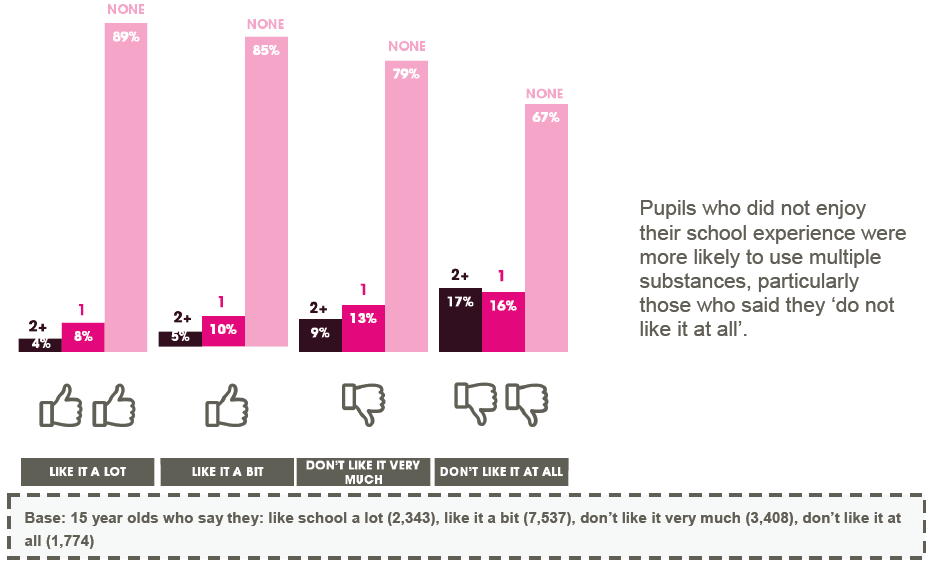
Figure 3.19: Number of substances used by pressure from school work among 15 year olds in 2013
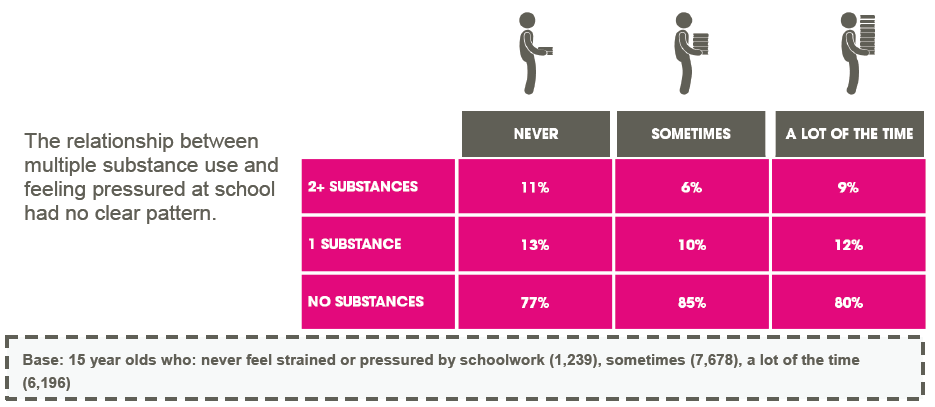
Figure 3.20: Number of substances used by number of times truanted among 15 year olds in 2013
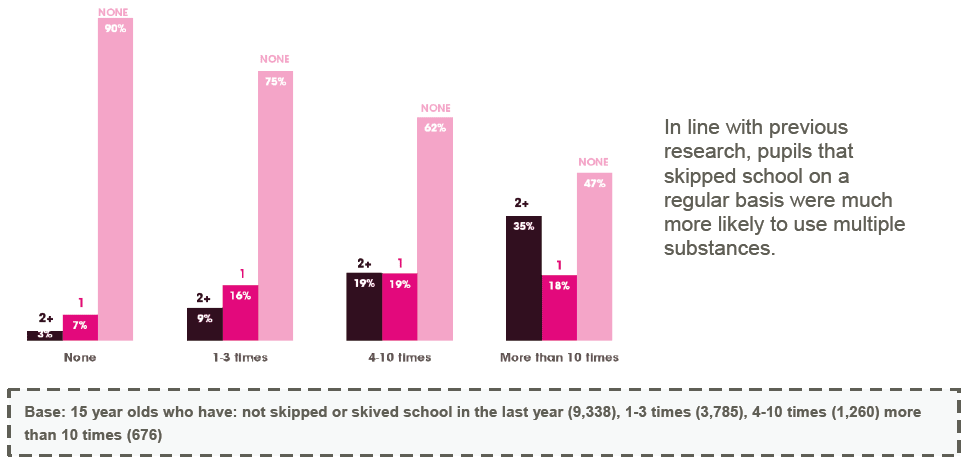
Figure 3.21: Number of substances used by exclusion among 15 year olds in 2013
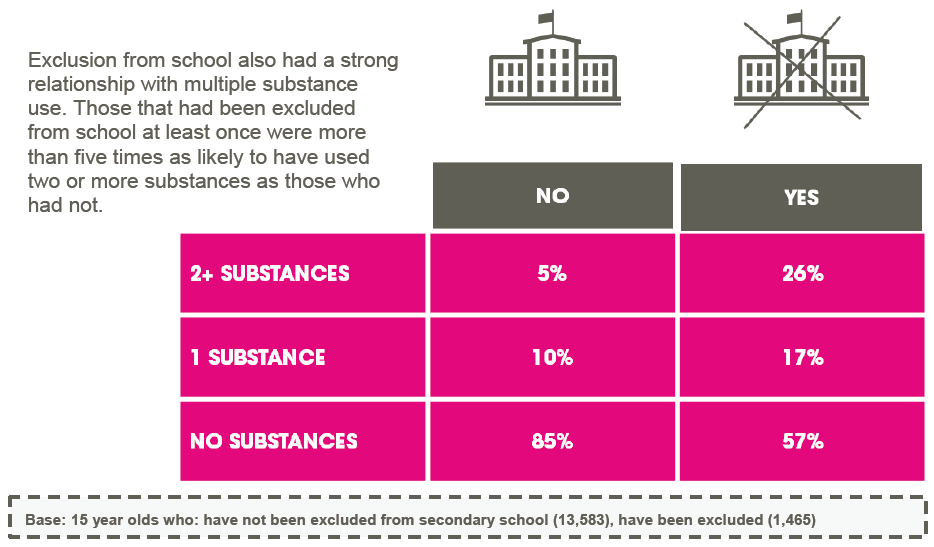
Figure 3.22: Number of substances used by aspirations among 15 year olds[17] in 2013
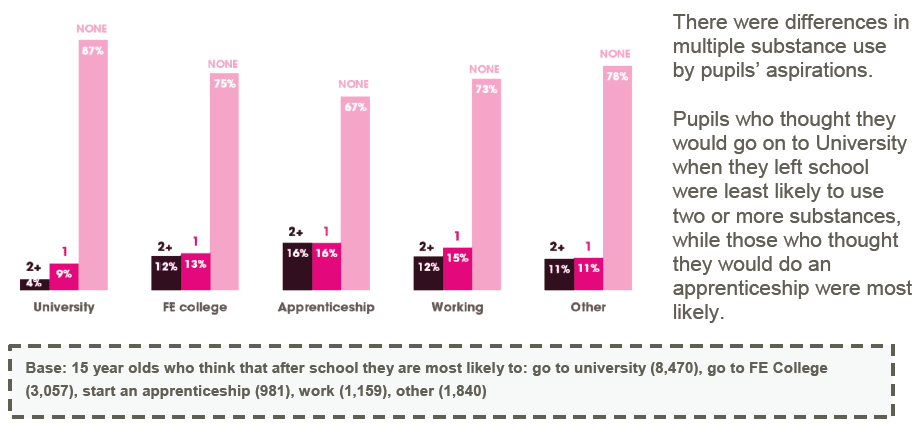
Leisure activities
Existing findings from other sources
- Hanging out with friends was associated with a higher prevalence of substance use specifically drugs and alcohol (5).
- Young people involved in structured leisure activities such as sports, volunteering or school clubs were less likely to engage in substance use (19).
- Unsupervised leisure time was associated with higher levels of substance use (20).
Figure 3.23: Use of two or more substances by whether participate in leisure activities among 15 year olds in 2013
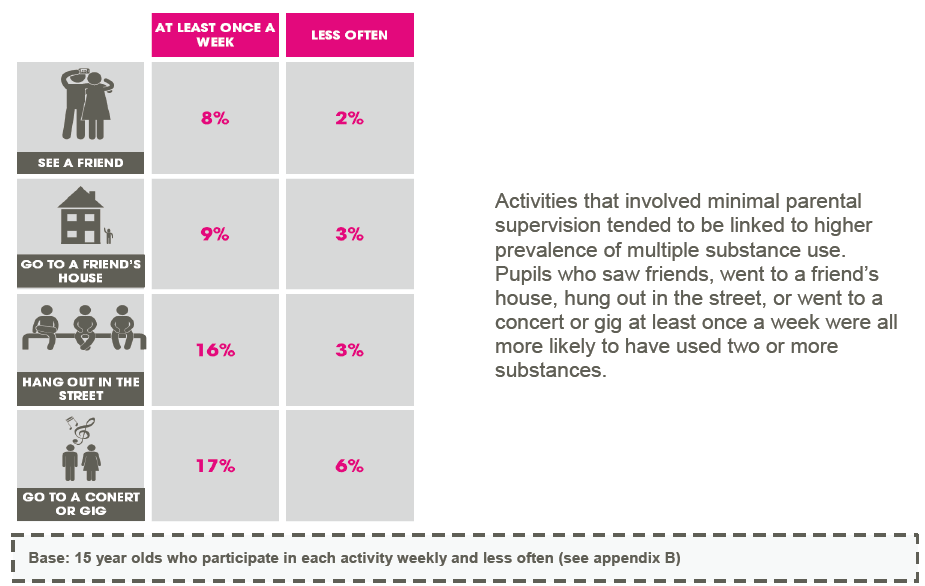
Figure 3.24: Number of substances used by group/club attendance among 15 year olds in 2013
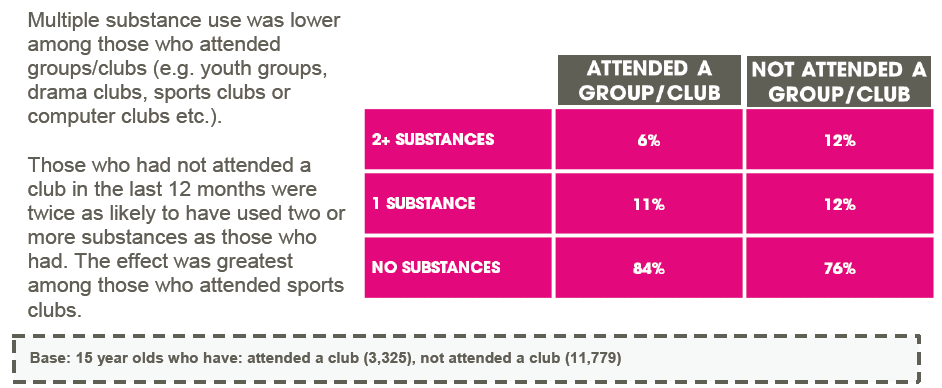
Ethnicity
Existing findings from other sources
- White pupils were more likely than Black or Asian pupils to have ever smoked cigarettes and to smoke regularly (21).
- Similarly, white pupils were more likely than those of other ethnicities to drink alcohol, either at all or in the last week (21).
- There were no differences in the prevalence of drug taking (ever, in the last year or in the last month) (21).
Figure 3.25: Number of substances used by ethnicity among 15 year olds in 2013
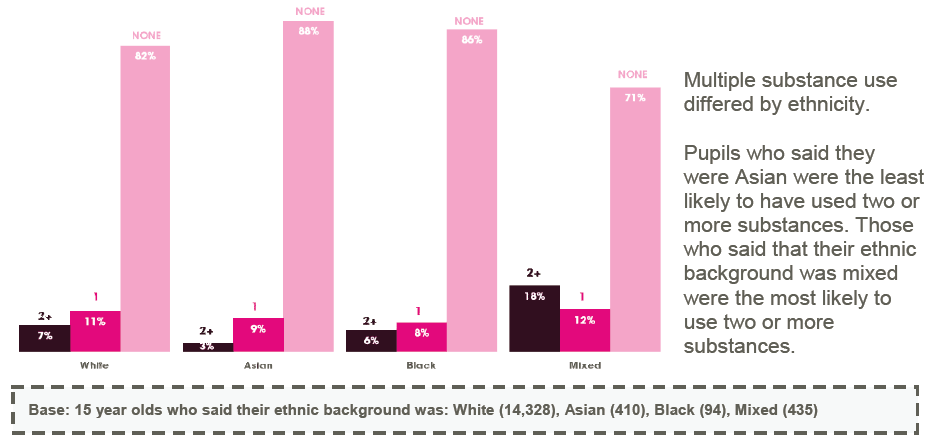
Contact
Email: Emma McCallum
There is a problem
Thanks for your feedback